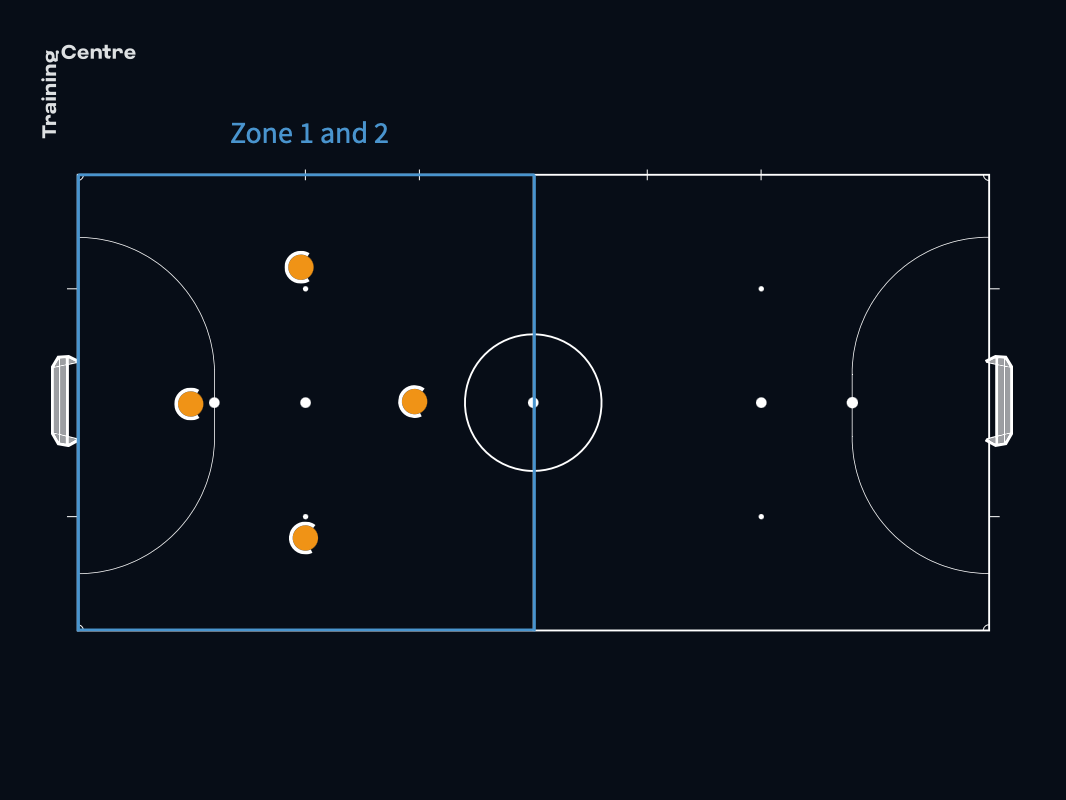The pros and cons of a low-block

Vietnam adopted this tactic in their games against Brazil and RFU, while teams like Lithuania, Venezuela and USA also chose to defend deep in this way.
The objective of defending in a low-block is to feel more protected, to keep the space to defend (last 15 metres) to a minimum and to play on the counter-attack after winning the ball or the opponent getting a shot in.
On the other hand, there is always danger when you are close to your goal, with the risk of shooting opportunities, a deflected shot or dangerous free kick leading to a goal.
Additionally, often when the ball is won back, having the entire team behind the ball makes it difficult to build a move or makes it much easier to counter-press the opposition, as shown in the video below.
Another important point worth bearing in mind is the reality of defending for 40 minutes with little sight of the ball and counting on the goalkeeper being able to cope with a lot of shots. This is why practically no team took this approach.
Types of approach to a low-block
Passive attitude
Little pressure is applied to the ball but the defending team sit deep
Aggressive attitude
Low-block press. How does this work?
-
The wingers move with the ball. There is an active approach to pressing the opposition winger just as he receives the ball.
-
The team moves as a unit from one side to the other based on where the ball goes. If it is a low-block press, the lines move up to a mid-block and then to a high block if that was the defensive plan.
Types of marking with a low-block
In a low-block, there was not one type of marking which was better or worse, or more or less effective. It was simply whether it was well executed or not. At the World Cup, we saw how, in this defensive position, most teams undertook man-to-man marking with defensive help and cover, and the defensive lines very close together. Only occasionally did defenders “pass players on” to a team-mate, given that a mistake in this area can prove fatal.
Phases of play in a low-block
In the defensive phase, with teams organised in a low-block, we could observe various diverse and specific moments of play:
-
Set-play kick-in in zone 1.
-
Set-play kick-in/free kick in zones 2 and 3 where the team were forced to defend in a low-block, but could immediately come up into a mid-to-high block.
-
Open play → The team are in a high block and there is a long kick (direct attack) by the goalkeeper to the pivot. The team drop back into a low-block, but as soon as they can, they move up into a mid- or high block.
-
Open play → The team are being overcome by the high press and defend in a low-block.
-
Open play → The team go ahead on the scoreboard and from the high block, intentionally move to a low-block.
-
Open play → The team are losing by three or four goals and do not want to concede any more. Initially defending in a high block, the team drop the defensive line to a low-block, thinking this would better protect them from conceding any further goals.
-
Open play → Teams who defended in a low-block and chased the ball aggressively, but who only went as high as the mid-block and stopped there to drop back again into the low-block. It was a means of getting the ball away from the danger area, while not going as far as the high block.
-
In a recovery phase, all the players get behind the ball in a low-block.
Tactical aspects of the low-block
Dealing with the pivot
An important point with defending deep like this is how to defend balls inside to the pivot. In general, teams were attacking this low-block with a 3-1 or 2-2 system, enabling a plentiful number of balls to the pivot. Overall, every team had clear ideas about how to defend in dangerous situations like this. Here are some of the ways this situation was resolved at the World Cup:
-
Some teams chose to defend man to man, with a clear individual responsibility for the defender up against the pivot, without any kind of defensive support from a team-mate. If the ball got to the pivot, each defender stayed with his attacker.
-
Some teams resolved this situation by defenders passing players on to a team-mate.
-
Almost every team tried to anticipate while defending. However, this is clearly very difficult and entails a big risk.
-
Another defensive solution widely adopted by teams was to “double-team” opponents, especially dominant pivots like Ferrão, Vinícius Rocha, Zicky Té, Francisco Solano, Andrei Afanasyev, Alan Brandi. Clearly, the timing has to be perfect since an attacker is momentarily left free.
-
In some cases, teams would risk a lot with almost all the players trying to get around the pivot to “seal him off”. If the ball gets played, it becomes a high-risk situation.
Flank coverage
The effectiveness of this low-block also depends on the type of cover for 1v1 situations on the flanks. When defending in a low-block, the attacking team have time to think and space to play their game. One such action, which is key to unlocking closed, deep defences, is a 1v1 down the wing. Without a defensive system with clear cover for every situation, this low-block can be “leaky”. The cover can come from each of the team-mates on the pitch. Here are some of the cases observed at the World Cup:
-
From the goalkeeper
-
From the primary defensive cover
-
From the defender who was marking the pivot, with the “opposite forward” taking over the job
-
From the “opposite forward”
Another important point following on from the previous situation of how to defend 1v1 in a low-block is that many teams chose to defend 1v1 against the best dribblers on the flanks. This was done with a quick defensive switch from the original formation to a 2-2 zonal system. This is to try to avoid the player with the ball running clear on goal if he gets the better of the player marking him. It requires a strong understanding between the players to quickly assign defensive roles and therefore, training of sufficient quality and quantity.



































